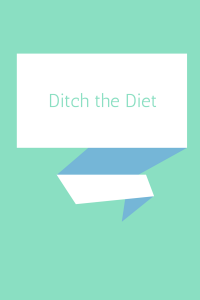Q: I can lose weight on diets, but then I get off track. I gain even more weight back than I lost. This has happened several times. I am tired of this. What do recommend?
A: Weight cycling (losing/gaining of weight) is a common pattern seen with chronic dieters. It can leave dieters feeling frustrated and hopeless. And ultimately feeling like a failure. I believe that diets fail, not the people who follow them. Diets fail because they usually don’t give us all the tools to be successful. Diets are really good at telling us what to eat and what not to eat–setting food rules. Some diets can be good at telling us how much to eat. But, diets don’t usually teach us to monitor our internal cues for hunger and fullness, how to eat at restaurants or parties, how to deal with emotional eating or binge eating, how to be flexible with food, take into consideration our food preferences, how to feed our families, etc.
There are many studies to support that dieting works–for awhile–but there isn’t much data to show the effectiveness of dieting with long-term weight loss. The dieting industry makes billions of dollars promoting their diets, pills, plans, etc. Well meaning health care professionals encourage patients to diet, which can often add fuel to the fire. Studies also show that dieting can increase the risk of eating disorders.
So what is a dieter to do? I encourage a more holistic approach.
1. Take stock in why you want to lose weight. Make a list of all of the reasons why you want to lose weight-health (be specific), looks, increase self-confidence, moving around easier, etc. Body weight is part of all of these-health, looks, self-confidence-but not all of it. Let’s take health for example. There are many ways to improve health-physical activity, eating nutrient dense foods, getting enough rest, etc. I encourage people to focus on all areas in order to meet their health goals not just weight loss.
2. Assess your eating style and rule our an eating disorder. According the Binge Eating Disorder Association, 30-40% of people seeking commercial weight loss services in U.S. meet the criteria for Binge Eating Disorder the most common type of eating disorder. Click here for a free and confidential eating disorder assessment tool.
Here are some questions to help assess your eating style: Are you a grazer? How many meals do you eat per day? Do you eat while distracted (working, watching TV, on devices)? What type of food do you eat most often? What types of foods do you like best? How often to you go to the grocery store? How often do you eat out or away from home? Do you know when you are hungry and when you are full? Do you eat when not hungry?
Once familiar with your eating style, it makes it easier to target behaviors you want to change in order to meet your goals.
3. Mindful Eating. Mindful eating is eating when you are hungry and stopping when you are full, eating all types of food (not just diet foods), taking both health and pleasure when considering food choices and eating without distractions. Once you have become clear about why you want to lose weight, have become familiar with your eating style (and ruled out an eating disorder) then begin to practice mindful eating. Be patient with yourself, changing eating habits take time.
